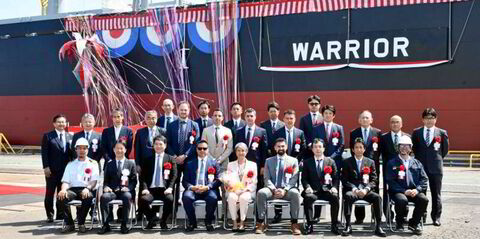The Philippines has been urged to form an integrated maritime and coastal command to improve security at sea.
Amparo “Mimi” Fabe, a security and business intelligence specialist, says piracy, kidnappings and terror threats mean the 260,000-square kilometre tri-border area straddling the Philippines, Malaysia and Thailand remains high risk.
Only this week it was reported that the boxship Ocean Kingdom (built 2000) was attacked by armed men in two speedboats off the southern coast of the Philippines.
In November last year, six Vietnamese seafarers, including the master and officers, onboard the 5,600-dwt bulker Royal 16 (built 2011) were seized by armed men off Sibago Island, near Lamitan City in the south-west Philippines.
A total of 24 Indonesian and 10 Malaysian seafarers were kidnapped in the region last year, resulting in the Indonesian armed forces chief declaring the waters off Malaysia and the Philippines unsafe, Fabe says. After the spate of kidnappings, Jakarta banned Indonesian-flag vessels from sailing to the Philippines.
Referring to a report by private intelligence company Strategic Forecasting (Stratfor), Fabe said: “Maritime threats have undermined the safety of the shipping lanes in the region’s narrow passageways, particularly the Makassar, Surigao, San Bernardino, Balabac, Lombok and Mindoro straits.
“Some of these corridors are used by tankers as alternative routes to the Strait of Malacca and they are vulnerable to criminal groups targeting freighters, tankers and bulk carriers.”
Speaking at the Dohle Group’s second Business and Economic Briefing on Shipping and the Philippines in Manila, Fabe — a member of the Association of Southeast Asian Nations’ International Working Group on the South China Sea — said the tri-border states hope to follow the Strait of Malacca with co-ordinated protocols, information-sharing and incident management reporting.
Fabe describes the threat in the tri-border area as still “significant”. In 2015, there were 11 reported incidents, with three attacks allegedly by the Islamist extremist Abu Sayyaf Group (ASG) targeting Malaysian and Indonesian vessels and involving crew kidnappings.
“These attacks resulted in the suspension of coal shipments to the Philippines, thefts of coal, paid ransoms and diverted routes,” she said. “The solution is stronger maritime co-operation between the three countries.
“Moreover, according to the Stratfor report, trade in the tri-border area is substantial. In 2015, more than 10,000 ships and 18 million passengers passed through the Celebes and Sulu seas with a cargo value of $440bn.”
Fabe identifies Aldren Bagadi, part of ASG, as being behind the kidnapping in November of the elderly German sailor Jurgen Kantner. “Aldren Bagadi has a total of 50 men but he can easily increase his manpower and firepower any time due to his alliances with the local militias,” said Fabe.
“The ASG is very familiar with the sea routes along the tri-border areas, including the Sulu Sea. Their kidnapping tactics are simple yet effective. They use motorised bancas [traditional local boats] or fast speedboats to overtake tugboats and fishing vessels. Less than 12 armed men attack at once. Before they carry out the attack, they have studied the area well. They also have the support of the local communities, where they keep their hostages.”
She says the ASG has a history of bombing shipping assets. “The world’s second-deadliest maritime terrorist attack happened on 27 February 2004, when the ASG bombed SuperFerry 14 and killed more than 100 people.
“The ASG is a resolute enemy. They kill, behead and maim their hostages. Hence, it is incumbent upon the captain and the company security officer that an updated safety and security plan is in place for a passage through the high-risk area.”
Fabe says the coastguard, Navy and National Police Maritime Group have worked together to patrol the Philippines’ territorial waters. According to a newspaper report in September, the armed forces had confiscated 200 high-powered ASG speedboats.
Protecting sea lanes is a primary concern of the government, says Fabe, who recommends that the Department of National Defense, the coastguard and the Department of the Interior and Local Government form an integrated maritime and coastal command in the southern and western provinces of Basilan, Sulu, Tawi-Tawi and Palawan with jurisdiction over the Philippines’ maritime domain and its porous coastal areas.
She also urges ship protection measures, including selecting crew members for anti-piracy training and redeploying NGOs such as Bantay Dagat, a volunteer sea patrol organisation, to develop onshore and offshore intelligence in coastal communities.


